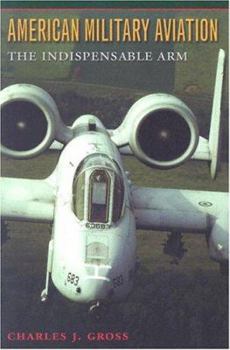American Military Aviation, 2: The Indispensable Arm
(Part of the Centennial of Flight Series Series)
Select Format
Select Condition 
Book Overview
Since the Wright brothers made their famed flight at Kitty Hawk in 1903, aviation has emerged as the indispensable arm of American military power. In this detailed and informative history, Charles J.... This description may be from another edition of this product.
Format:Paperback
Language:English
ISBN:1585442550
ISBN13:9781585442553
Release Date:September 2002
Publisher:Texas A&M University Press
Length:392 Pages
Weight:1.50 lbs.
Dimensions:1.1" x 6.2" x 9.2"
Related Subjects
Aviation History Military Military Science Modern (16th-21st Centuries) TransportationCustomer Reviews
2 ratings
The Best Overall History of American Air Power
Published by Thriftbooks.com User , 19 years ago
Dr. Charles Gross, the official Air National Guard Historian, has written a history of American air power that will stand as the definitive synthesis for many years to come. Scholars will find this book to be an invaluable one-volume guide to the field; military personnel involved in aviation will revere the book as essential professional reading; and general readers, looking for a critical history of the subject, will find everything they need and more between its covers. American Military Aviation's thesis, as its subtitle implies, is that air power has emerged as "indispensable" for each of America's armed services. No branch can dare ignore its impact on all levels of conflict, ranging from logistics and intelligence to combat operations on land, sea, in the air, and even space. On the other hand, Gross is quick to point out that air power is not the panacea for all of the United States's military problems. Air power can be limited by geography as well as political constraints. It also cannot always defend the country against asymmetrical threats, as the 9-11 terrorist attacks so vividly illustrated. "In many respects," the author argues, "the central theme of the history of American military aviation has been the continuing struggle to adapt aircraft to the changing operational requirements, doctrines, and competing organizational interests of the armed forces while accommodating evolving national strategies."(293) This sentence also neatly captures the essence of the author's history: a thorough examination of the roles of politics, economics, and technology in shaping air power in each of America's armed services, including the Army and Marine Corps. For Gross, during the nascent years of American military aviation, air power enthusiasts had to struggle just to be noticed. In 1917, the U.S. aviation industry consisted of just a few struggling firms, and most of its designs were completely out of date by European standards. In fact, American designs did not begin to catch up with European standards until after the war. What transformed U.S. military aviation from a flock of fledgling chickens to an armada of eagles were the demands of World War I and the "incredible notion"(29) held by many U.S. policymakers that aviation would be one of America's key contributions to the war. In the end, however, U.S. and Allied air power played a "distinctly supporting role to established ground and naval forces."(298) Observation proved to be the most valuable contribution by aircraft during the First World War. Moreover, most of the planes fielded by U.S. squadrons were designed and built in Europe. The American aviation industry focused most of its attention during this period building trainers, not fighters as popular legend would have it. The interwar period was the first period of true innovation by American aviation. During this era, technological innovations allowed many American pilots to capture aviation speed a
An Astute Synthesis
Published by Thriftbooks.com User , 21 years ago
Charles J. Gross undertook to write an up-to-date synthesis of American military aviation, something that does not exist, and succeeded admirably. He argues that for all of the arguments from air power advocates in favor of the use of the airplane for combat operations to the exclusion of ground and naval forces, we are still dependent on land, sea, and air forces as a balanced set of assets for the execution of military power. This is an important issue in the current world, as modern strategists echo the arguments of Billy Mitchell and others about the primacy of the airplane. This book is an important corrective to such overzealousness and an important reminder of the way in which the various combat forces interact.






